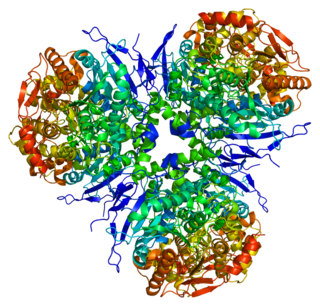Glucuronidase may refer to several enzymes:
Glucuronidase may refer to several enzymes:

Aspartic acid (symbol Asp or D; the ionic form is known as aspartate), is an α-amino acid that is used in the biosynthesis of proteins. Like all other amino acids, it contains an amino group and a carboxylic acid. Its α-amino group is in the protonated –NH+
3 form under physiological conditions, while its α-carboxylic acid group is deprotonated −COO− under physiological conditions. Aspartic acid has an acidic side chain (CH2COOH) which reacts with other amino acids, enzymes and proteins in the body. Under physiological conditions (pH 7.4) in proteins the side chain usually occurs as the negatively charged aspartate form, −COO−. It is a non-essential amino acid in humans, meaning the body can synthesize it as needed. It is encoded by the codons GAU and GAC.

Sly syndrome, also called mucopolysaccharidosis type VII (MPS-VII), is an autosomal recessive lysosomal storage disease caused by a deficiency of the enzyme β-glucuronidase. This enzyme is responsible for breaking down large sugar molecules called glycosaminoglycans. The inability to break down GAGs leads to a buildup in many tissues and organs of the body. The severity of the disease can vary widely.

Mucopolysaccharidoses are a group of metabolic disorders caused by the absence or malfunctioning of lysosomal enzymes needed to break down molecules called glycosaminoglycans (GAGs). These long chains of sugar carbohydrates occur within the cells that help build bone, cartilage, tendons, corneas, skin and connective tissue. GAGs are also found in the fluids that lubricate joints.
A fecal coliform is a facultatively anaerobic, rod-shaped, gram-negative, non-sporulating bacterium. Coliform bacteria generally originate in the intestines of warm-blooded animals. Fecal coliforms are capable of growth in the presence of bile salts or similar surface agents, are oxidase negative, and produce acid and gas from lactose within 48 hours at 44 ± 0.5°C. The term "thermotolerant coliform" is more correct and is gaining acceptance over "fecal coliform".

A glucuronide, also known as glucuronoside, is any substance produced by linking glucuronic acid to another substance via a glycosidic bond. The glucuronides belong to the glycosides.

β-Glucuronidases are members of the glycosidase family of enzymes that catalyze breakdown of complex carbohydrates. Human β-glucuronidase is a type of glucuronidase that catalyzes hydrolysis of β-D-glucuronic acid residues from the non-reducing end of mucopolysaccharides such as heparan sulfate. Human β-glucuronidase is located in the lysosome. In the gut, brush border β-glucuronidase converts conjugated bilirubin to the unconjugated form for reabsorption. β-Glucuronidase is also present in breast milk, which contributes to neonatal jaundice. The protein is encoded by the GUSB gene in humans and by the uidA gene in bacteria.
In biology, a marker gene may have several meanings. In nuclear biology and molecular biology, a marker gene is a gene used to determine if a nucleic acid sequence has been successfully inserted into an organism's DNA. In particular, there are two sub-types of these marker genes: a selectable marker and a marker for screening. In metagenomics and phylogenetics, a marker gene is an orthologous gene group which can be used to delineate between taxonomic lineages.

The GUS reporter system is a reporter gene system, particularly useful in plant molecular biology and microbiology. Several kinds of GUS reporter gene assay are available, depending on the substrate used. The term GUS staining refers to the most common of these, a histochemical technique.
Enzyme potentiated desensitization (EPD), is a treatment for allergies developed in the 1960s by Dr. Leonard M. McEwen in the United Kingdom. EPD uses much lower doses of antigens than conventional desensitization treatment paired with the enzyme β-glucuronidase. EPD is approved in the United Kingdom for the treatment of hay fever, food allergy and intolerance and environmental allergies.
For beta-glucuronidase, see Beta-glucuronidase
In enzymology, a glycyrrhizinate β-glucuronidase (EC 3.2.1.128) is an enzyme that catalyzes the chemical reaction

Liver carboxylesterase 1 also known as carboxylesterase 1 is an enzyme that in humans is encoded by the CES1 gene. The protein is also historically known as serine esterase 1 (SES1), monocyte esterase and cholesterol ester hydrolase (CEH). Three transcript variants encoding three different isoforms have been found for this gene. The various protein products from isoform a, b and c range in size from 568, 567 and 566 amino acids long, respectively.

UDP-glucuronosyltransferase 1-8 is an enzyme that in humans is encoded by the UGT1A8 gene.

In molecular biology, Glycoside hydrolase family 2 is a family of glycoside hydrolases EC 3.2.1., which are a widespread group of enzymes that hydrolyse the glycosidic bond between two or more carbohydrates, or between a carbohydrate and a non-carbohydrate moiety. A classification system for glycoside hydrolases, based on sequence similarity, has led to the definition of >100 different families. This classification is available on the CAZy web site, and also discussed at CAZypedia, an online encyclopedia of carbohydrate active enzymes.

In molecular biology, glycoside hydrolase family 4 is a family of glycoside hydrolases EC 3.2.1., which are a widespread group of enzymes that hydrolyse the glycosidic bond between two or more carbohydrates, or between a carbohydrate and a non-carbohydrate moiety. A classification system for glycoside hydrolases, based on sequence similarity, has led to the definition of >100 different families. This classification is available on the CAZy web site, and also discussed at CAZypedia, an online encyclopedia of carbohydrate active enzymes.

Aceglatone (Glucaron) is an antineoplastic drug available in Japan.

X-Gluc is a chemical compound with the molecular formula C14H13BrClNO7. It is used as a reagent to detect β-glucuronidase, an enzyme produced by the E. coli bacterium. It is used to detect E. coli contamination in food, water and the urinary tract. In addition, it is widely used in molecular biology experiments to mark and select the expression of target genes (GUS reporter system).
Xylan alpha-1,2-glucuronosidase is an enzyme with systematic name xylan 2-alpha-D-(4-O-methyl)glucuronohydrolase. This enzyme catalyses the following chemical reaction
Baicalin-beta-D-glucuronidase (EC 3.2.1.167, baicalinase) is an enzyme with systematic name 5,6,7-trihydroxyflavone-7-O-beta-D-glucupyranosiduronate glucuronosylhydrolase. This enzyme catalyses the following chemical reaction

Estradiol 3-glucuronide (E2-3G), also known as 17β-estradiol 3-(β-D-glucuronide), is a naturally occurring and endogenous estrogen conjugate. It is specifically the C3 glucuronide conjugate of estradiol, the major estrogen in the body. It is formed from estradiol in the liver by UDP-glucuronosyltransferase via attachment of glucuronic acid and is eventually excreted in urine and bile. Similarly to estrogen sulfates like estrone sulfate, estrogen glucuronides have much higher water solubility than do unconjugated estrogens like estradiol.